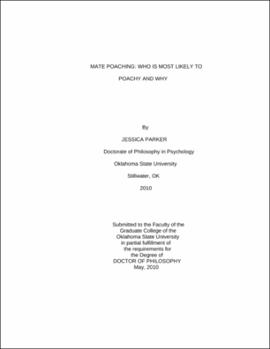| dc.contributor.advisor | Burkley, Melissa | |
| dc.contributor.author | Parker, Jessica | |
| dc.date.accessioned | 2013-11-26T08:27:44Z | |
| dc.date.available | 2013-11-26T08:27:44Z | |
| dc.date.issued | 2010-05 | |
| dc.identifier.uri | https://hdl.handle.net/11244/6969 | |
| dc.description.abstract | Scope and Method of Study: The purpose of these two studies was to determine who is more likely to mate poach and why. Study 1 was designed to identify what types of women are more likely to engage in mate poaching. It was predicted that women who possess negative relational attitudes would be more likely to engage in mate poaching behaviors. A second study was designed to investigate potential motives for mate poaching—self-esteem, appearance threats, and competition. Specifically, it was predicted that in an attempt to restore self-esteem, appearance-contingent women would be more likely to mate poach following a threat to their appearance self-esteem. Combined, these studies offer insight into the behavior of mate poaching. | |
| dc.description.abstract | Findings and Conclusions: These two studies are unique because they offer novel insight into the motives and behaviors of the female mate poacher. In Study 1, I explored the question of who is most likely to mate poach by identifying a profile of a female mate poacher. Results suggest that she is most likely to be a single woman, who bases self-worth on having romantic relationships, and who would rather be "the mistress" as compared to "the wife being cheated on." She also possesses permissive sexual attitudes and other negative, relational attitudes. Furthermore, she is the woman who frequently engages in negative relational behaviors, and who believes there is nothing wrong with engaging in mate poaching tactics. These results are the first to provide such a detailed description of a female mate poacher. | |
| dc.description.abstract | Study 2 attempted to explain an underlying mechanism for female mate poaching behaviors. It was predicted that an appearance threat would differentially affect appearance-contingent and appearance-noncontingent women's willingness to pursue an attached guy. Although my overall hypotheses were not supported, I argue that appearance contingency of self-worth and appearance threats may still be important underlying factors in female mate poaching, but issues with the study's prescreening and appearance threat procedures led to the lack of significant findings. | |
| dc.format | application/pdf | |
| dc.language | en_US | |
| dc.rights | Copyright is held by the author who has granted the Oklahoma State University Library the non-exclusive right to share this material in its institutional repository. Contact Digital Library Services at lib-dls@okstate.edu or 405-744-9161 for the permission policy on the use, reproduction or distribution of this material. | |
| dc.title | Mate poaching: Who is most likely to poach and why? | |
| dc.contributor.committeeMember | Grice, James | |
| dc.contributor.committeeMember | Gardner, Brandt | |
| dc.contributor.committeeMember | Byrd-Craven, Jennifer | |
| dc.contributor.committeeMember | Burkley, Ed | |
| osu.filename | Parker_okstate_0664D_10801.pdf | |
| osu.accesstype | Open Access | |
| dc.type.genre | Dissertation | |
| dc.type.material | Text | |
| dc.subject.keywords | appearance contingency of self-worth | |
| dc.subject.keywords | competition among women | |
| dc.subject.keywords | mate poaching | |
| dc.subject.keywords | self-esteem | |
| thesis.degree.discipline | Psychology | |
| thesis.degree.grantor | Oklahoma State University | |
